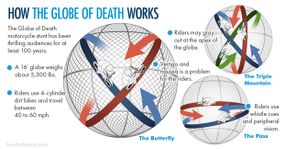Globe of Death. Sphere of Fear. Or, for the squeamish, Globe of Steel. Whatever you call it, it's a trick that's been around nearly as long as there have been motorcycles. A man on a motorcycle enters (through a trap door) a sphere made of steel belts riveted together. There may or may not be dramatic music, sweeping lights and the occasional sparkler. Then the man on the motorcycle twists his right wrist, rocks back and forth a bit, and launches up the side of the globe. He can go around sideways, at right angles to the rest of the world, or he can loop-the-loop from the North Pole to the south. If he's really confident in himself and his motorcycle riding friends or family, he'll allow other riders to enter the globe with him. The riders may even have someone stand in the center of the sphere while they whirl around defying gravity.
The brilliance of the Globe of Death — we're not squeamish here — is in its simplicity. The Globe of Death requires only three things: a big metal globe, a motorcycle and a rider. Despite its dramatic name, it does not require death. As a matter of fact, death is a big no-no in this act. But anyone who's ever felt the g-forces of the loop-the-loop section of a roller coaster or even taken a high-banked corner on a racetrack gets the basic idea of what's going on here. And yet! The act still seems so death-defying and difficult, which explains why the Globe of Death has been a popular act for more than a century. Let's dig into what makes this trick tick.
Advertisement




